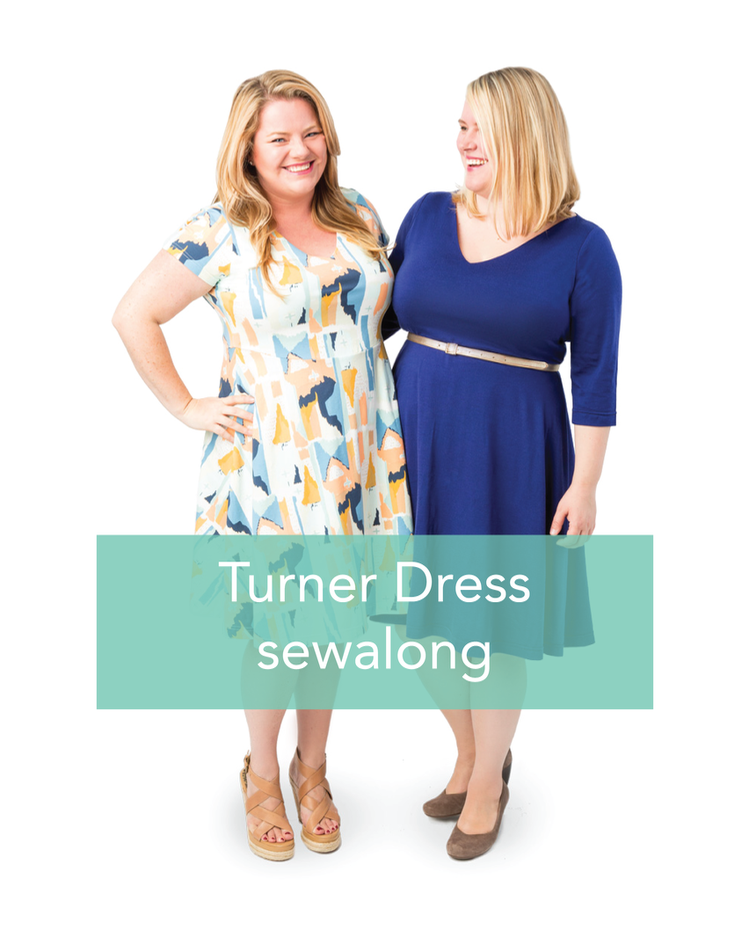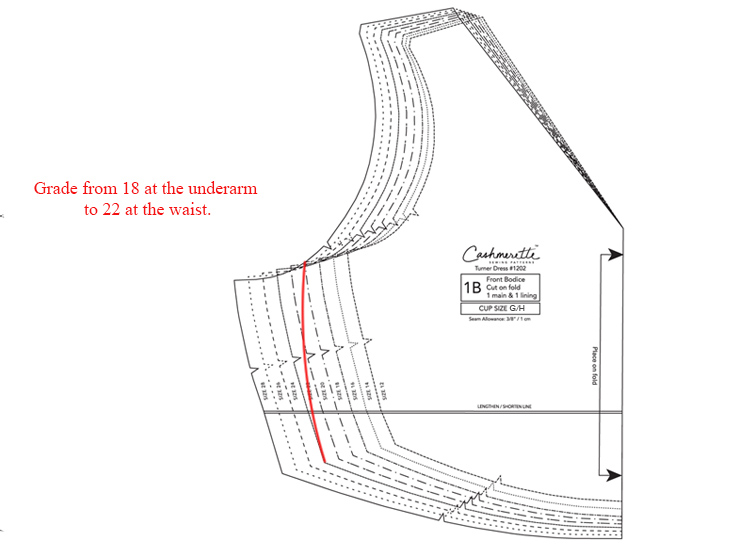
Today we’re going choose our size, grade between sizes if necessary, and get our pattern and fabric all ready to go, so we can start sewing our Turner Dresses next time!
The first decision to make when sewing a Turner Dress is which size to choose. Thanks to the three cup sizes it’s more likely that you’ll fit in a “straight” Cashmerette Pattern than many other companies, but of course we all vary and chances are you may not be perfectly in one size. The good news is that sewing gives you tons of flexibility, and it’s easy to grade between sizes.
How to choose your size
There are two measurement charts: one is the Body Measurement chart, and the other is the Finished Garment chart. The Body Measurement chart helps you choose your size based on what numbers you get when you measure your body with a tape measure – it has numbers for your bust (around the fullest part), waist and hip. The Finished Garment chart shows you the size of the actual sewn garment – the difference between that and the Body Measurement chart is called “ease”, and it’s the amount of extra room in the garment that the designer recommends for the clothes to fit well and allow movement.
Generally, you want to start by comparing your measurement with the body measurement chart. However, if your measurements are between sizes you can take a look at the Finished Garment chart to see if you can fit in just one. The Turner Dress is designed with negative ease at the bust, no ease at the waist, and a lot of positive ease at the hips, so if you fit into the size 12 bust and waist but your hip is a bit bigger, say 45″, you’ll probably still fit in the size 12 just fine! The most important measurements for this dress are the bust and waist.

As with all Cashmerette Patterns, the best bet is to start with your bust measurement – you should use your full bust measurement, which is around the fullest part of your bust. Because of the cup sizing, you may find you could fit in two different bust sizes – in which case, you want to pick the overall size that’s closest to your waist size. So for instance, if your bust is 44″, you could theoretically be a 14 G/H or a 16 C/D. Which one should you pick? Take a look at the waist measurement – if yours is closer to 34″ (size 14), then go with the 14 G/H. If yours is closer to 36″ (size 16), then go with the 16 C/D.
Don’t fret if the cup size doesn’t match up with your bra size – there is so much variation in bra sizing that it’s not possible to perfectly line them up. Use your actual bust measurement and you’ll be fine.
Grading Between Sizes
The Turner Dress is a super easy pattern to grade! Let’s say your bust measurement is 48″, your waist measurement is 42″, and your hip measurement is 50″. Based on these measurements, you’d want the 18 G/H bust, a size 22 waist, and a size 20 hip.

To grade between the 18 bust and the 22 waist, you’ll want to start just below the seam allowance under the arm on the side seam of the front bodice piece and grade to just above the seam allowance on the waist seam. You can start by connecting these two points with a straight line and then base the curve off that.

Next, you’ll want to repeat these steps with the back bodice piece. One thing to check before you cut your pattern pieces out is that the side seams are the same length. Walk your ruler along the new line on both the front and the back and either add or take away curve to make the measurements the same. I usually adjust the curve on the back piece to accommodate the length I’ve established on the front piece.

So now, our waist is the size 22. Because the hip fit in this pattern isn’t essential, I would cut a straight size 22 for the skirt. If you try it on and the ease around the hips feels too much, you can always take in the skirt on the side seams.
Preparing Pattern and Fabric
Now that we’ve chosen our size and graded if necessary, it’s time to prepare our pattern and fabric so that we’ll be all ready to sew next time!
Here’s your checklist:
- Wash and dry your fabric, to make sure it’s pre-shrunk and you’re not going to get any nasty surprises later! This is especially important with knits. They can shrink an incredible amount!
- Press your fabric so it’s nice and flat. Check to see if you get any iron shine when you press the right side. If so, you’ll want to use a press cloth when pressing between steps.
- If you’re using a printed pattern, either cut or trace off your pattern pieces – if you’re making adjustments or are going to make any dresses in other sizes in the future, I definitely recommend tracing.
- If you’re using a PDF pattern, you’ll need to print and assemble it. Here are some pointers to help you.
- Transfer all the markings to the fabric. For the notches, make a little snip into the fabric, within the seam allowance (so no more than 1/4″/6mm).
- Cut all pieces, following the layout diagrams in the pattern.
Next time, we’ll assemble the bodice of our Turner Dress!

My bust is 40″ and waist 36 1/2″. I don’t like knits to be too fitted and so I’m a bit unsure as to the best size to choose. I made the Appleton dress (as a top) in a size 12 and it was far too clingy.
Based on your measurements, you’d want to cut a 12 C/D and grade to a 16 in the waist; that said, if you don’t like your knits too clingy, you could try making a straight 16 C/D and bring it in at the side seams after trying it on if it feels too loose!
Thank you I’ll see how it goes.
I’m late to the party and am still trying to decide on my sizing. I find myself completely confused with using the full bust and then picking a cup size. On the size chart a 48″ bust is both applicable to the size 18G/H and the 20C/D So in the case of your example “Let’s say your bust measurement is 48″, your waist measurement is 42″, and your hip measurement is 50″. Based on these measurements, you’d want the 18 G/H bust, a size 22 waist, and a size 20 hip.” Why didn’t you just go with the 20 C/D. I have the turner dress and concord tee and can’t figure out how to select which cup size. My measurements are bust 47″, waist 44″ and hip 55″. So should I go with an 18 E/F bust and grade it to a 24 waist? I’ve been trying to figure this out on my own but would love some help!
You could either do 18 E/F to the 24 waist, or a 20 C/D to the 24 waist to give you a little less to grade between.
Thanks Jenny!
Thanks for the info!
I have so many of your patterns Pinned! I’m determined to do dresses, leggings and cardigans this year. Grateful for your grading tips in this post and the comments. My head was in a spin! My measurements are 52-46-46; I wear an H cup bra. As I’d already printed off the G/H pattern, I chose to grade 22-26-26. Trying not to get all up in my head about the sizing! In NZ, I’d be a 20-22 top, 16-18 bottom 😀 Trust is the key action here!
I need some sizing advice. I made size 18 c/d and the fit is great except the shoulders are way to wide. I’d guess I need two sizes down in the shoulders. Would it be best to grade from size 14 c/d in the shoulders to a 18 c/d in the bust (since I’m happy with the fit in the bust, om should I go with the 14 g/f and grade to a 18 at waist?
You can do a narrow shoulder adjustment: https://blog.cashmerette.com/2016/09/tutorial-how-to-narrow-shoulders-alter-a-necklin.html
Hi, could you please give me advice too on picking a size for Turner dress. I’m bust 46″, waist 38″ and hips 50″. Is 18 c/d the best size. Seems like a lot of negative ease (I’m in my 50s!). Thank you very much. Sheila
Hi Sheila – yes you should fit well in the 18 C/D
Hi, I’m trying to get a head start by ordering my fabric while waiting for my pattern to arrive! Every knit print I’ve found and liked is 58” wide not 60”, just how crucial is it to use 60” wide fabric? I’ll most likely make this in a size 18-20, grading between sizes.
It won’t be an issue for you (there’s a small chance it would be problematic at the biggest sizes, but even then you’d probably be OK).
Thanks!
Hi Jenny, Change in plan. I want to use the skirt portion of the Turner for a Alabama Chanin style swing skirt. I plan to use a double layer of Telio organic jersey knit from fabric.com. It has 30% stretch across the grain. In your best estimation since you know the pattern’s fit, should I sew the size that is my actual waist measurement or go down one size. I may alter the pattern by turning it into a four panel skirt by dividing the pattern piece. Please keep in mind I don’t like real clingy knits.
I’m also using your Concord Tee for an AC top but I’ll ask my questions on that page.
The fabric I am interested in is a poly ity but with 40% stretch. Can I use it and adjust the size due to the lack of stretch? If so, what would be the suggestion for sizing? I measure 42.5 – 38 – 44. I realize I will be doing some grading.
40% stretch will probably be sufficient.
For me, cutting out the fabric seems to be the part that took the longest. My 1st Turner will be from 2 pieces I bought from the site during the “remnants” sale…